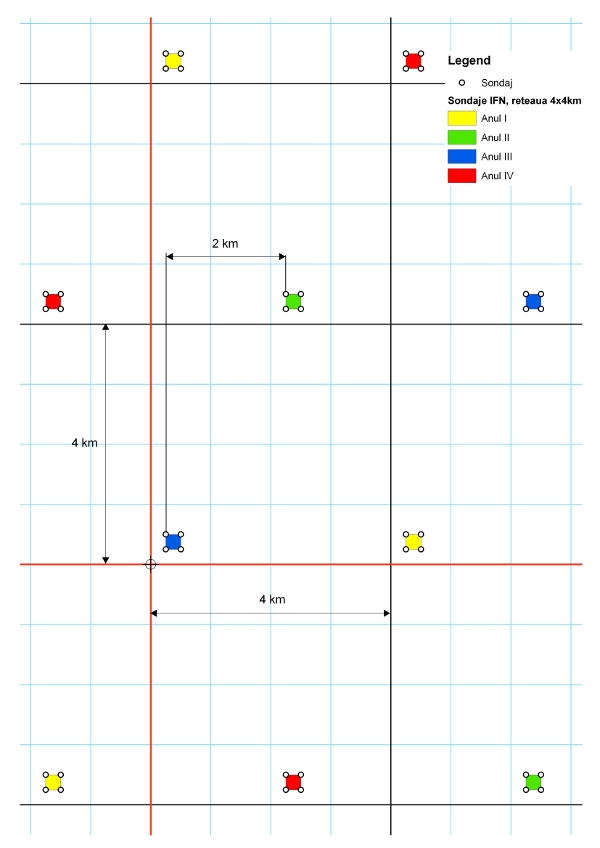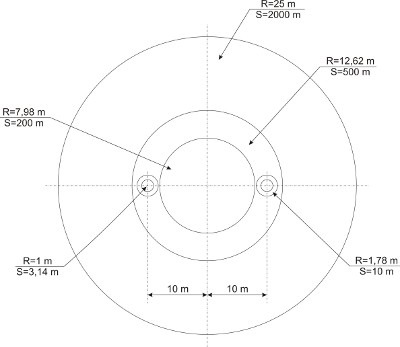About IFN
The national forest inventory (IFN) was initiated in 2006. It is designed to cover the entire forest vegetation in Romania, respectively the national forest stock, the forest vegetation outside the national forest fund and the trees outside the forest. The National Forestry Research and Development Institute (INCDS) “Marin Drăcea” is responsible for the design and implementation of IFN, for carrying out field measurements, processing and analyzing IFN data and publishing the obtained results. IFN is inspired by different forest inventories currently used in European countries, with adaptations corresponding to the characteristics of the forest vegetation and relief conditions in Romania.
The development of IFN in Romania
The creation of a forest inventory at the national level was determined by the high interest in obtaining information about forest resources in Romania, due to the development of the wood processing industry during the 1950s.
Starting with 1948, all Romanian forests became public property and began to be managed by the state in a unitary manner, through the implementation of a unitary forest management planning system for the national forest stock. After all the forests were uniformly managed, the tradition was to periodically make inventories of the forest stock by updating and aggregating the data from the forestry management planning. Based on the information contained in the forestry management planning, inventories of the forest stock were drawn up in 1965, 1973, 1980 and 1984.
IFN is a modern, multi-purpose inventory that provides information about forests far beyond that resulting from simple forest measurements. Therefore, the new IFN was designed from the beginning to allow measurements to be carried out in a systematic network of sample areas and the collection of all data that would ensure both the provision of information necessary for the development of the main indicators of sustainable forest management and reporting information on the carbon stored in forest ecosystems in accordance with the provisions of the Kyoto Protocol, as well as information on the biological diversity of forests.
A pilot inventory was carried out in 2007, in order to verify the feasibility of the developed methods, their adaptation when necessary and to ensure a good inter-calibration between the teams collecting the IFN field data.
Use of information
Since the last inventory of the national forest stock was made 25 years ago, there is currently an acute lack of current information on national forest resources and their condition, both from the public and private sectors.
The IFN information will be used to develop the national forestry policy, which will be expressed in the strategies, legislation and national forestry programs for the sustainable management of forests. They will also be used in decision-making processes regarding the development of the forest industry and intersectoral collaboration, in providing information on forest resources to national and international bodies (FAO Forest Resources Assessment and the Ministerial Conference for the Protection of Forests in Europe) and to provide information on carbon storage and biological diversity in forest ecosystems, the state of health of forests, injuries caused by various factors, etc.
The sampling project
The Romanian IFN is designed as a continuous forest inventory (CFI), with a periodicity of the inventory cycle of five years. It is based on systematic sampling, combines repeated measurements in permanent sample plots with measurements in temporary sample plots and is a two-stage NFI (forest assessments and measurements on orthophoto planes and then in the field). IFN uniformly covers the entire territory of the country and is based on a 4×4 km network (Fig. 1). The density of the network is higher in the plain area (2×2 km) due to the very low coverage with forest vegetation. The placement of the test surfaces in the network is shown in Fig. 2.
To determine the area of land with forest vegetation and the coverage/use of land at the national level, a systematic network of 500x500m is used that uniformly covers the entire territory of the country.

Fig.1. Map of Romania. IFN networks of 4x4km and 2x2km

Fig.2. IFN 4×4 km network by years of field data collection
In order to increase the efficiency of field work, the measurements are made in sample areas grouped by 4 in surveys. A survey has the shape of a square with a side of 250 m and is located in the southwest corner of a square in the 4×4 (2×2) km grid (fig. 3). In the 4 corners of the survey there is an IFN sample area. At the end of a five-year IFN cycle, approximately 24,000 permanent test areas and 5,000 temporary test areas will be covered with fieldwork. Temporary test surfaces are also systematically selected.

Fig.3. Structure of a survey: four sample areas located in the corners of a square and four sides of the survey
Each sample surface contains several circles (Fig. 4), as follows:
- Two concentric circles located 10 m on either side of the center of the test surface, in the east-west direction, to measure the regeneration, as follows:
- two circles with a radius of 1.00 m for measuring saplings/trees from 10 cm to 50 cm high;
- two circles with a radius of 1.78 m for measuring saplings/trees over 50 cm high and with a diameter (DBH) under 56 mm.
- Three concentric circles located in the center of the test surface:
- a circle with a radius of 7.98 m for measuring sample trees with 56 ≥ DBH ≤ 285 mm, fallen dead wood, stumps and indicator flora;
- a circle with a radius of 12.62 m for measuring sample trees with DBH 285 mm;>
- a circle with a radius of 25m for the description of the forest station, the type of forest, the forest soils and the edges of the forest.
The set of measurements performed in each sample area was designed not only to estimate forest resources and forest growth, but also to allow accurate reporting of the amount of carbon stored in forest ecosystems. Therefore, in addition to the classic biometric measurements of trees, soil characteristics are also described and samples are taken for laboratory analysis in order to determine the amount of organic carbon stored in forest soils.
Since IFN is the first systematic national forest inventory, carried out after a long period of time, the estimation of forest growth is based on dendrochronological measurements. The field teams systematically collect growth cores from 3 – 6 trees from each sample area, and these are processed in order to correctly estimate the age of the trees and their growth during the last 5 years.

Fig.4. The composition of a sample surface. Each circle represents a different sampling area with measurement.
Estimation techniques
The estimation of the area of land with forest vegetation is based on the total area of the country, which is known and assumed to be free of errors, and on the proportion of points in the 500x500m IFN network located in land with forest vegetation from the total points in this network.
The volume is estimated based on a regression equation, with DBH and height as input variables. This equation has a high precision, and the regression coefficients have been “customized” for the most important 43 tree species. For coniferous species, the equations refer only to the volume of the spindle, without branches. The height is measured for each sample tree.
The estimation of the total amount of wood harvested from the lands with forest vegetation is currently based only on the annual statistical reports made by the forest departments and the forestry companies. The measurements carried out in the permanent IFN sample areas, including the stumps, will allow the precise estimation of the amount of wood harvested from the lands with forest vegetation.
Perspectives
The Romanian IFN was created for multiple purposes and is based on a system of systematic sampling of lands with forest vegetation. Field data collection began in 2008 and was completed at the end of 2012.
Romania has a great diversity of landforms, and the forests are mainly located in mountainous and hilly areas, which are difficult to access, especially due to the lack of transport facilities. But the working method adopted, the tools and equipment of the IFN ensure the development of a high-performance forest inventory, which can provide all the necessary data for a precise estimation of forest resources and detailed reporting of its characterization indicators.
The IFN is not only focused on determining the composition and volume of forests, but will also provide estimates regarding the amount of carbon in forest ecosystems and their biological diversity, forms of forest ownership, health status and accessibility, etc. Indeed, special attention has been paid to ensure that the IFN information provides the reporting of sustainable forest management indicators and is in line with the good practice guidelines recommended by the UN Framework Convention on Climate Change, as well as with those for assessing diversity biology of forests.

